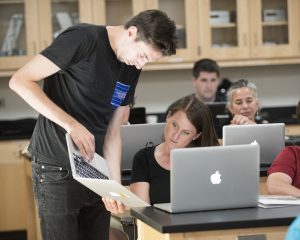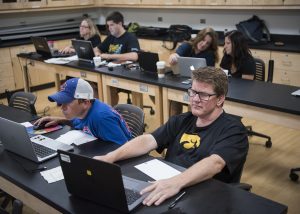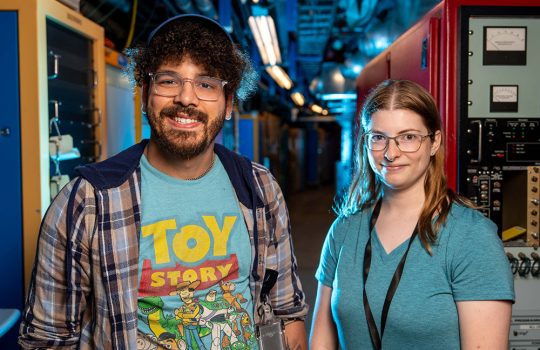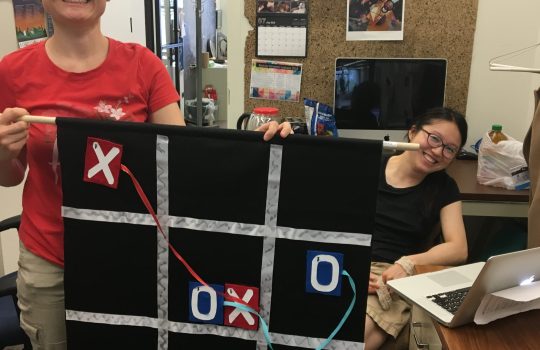
Fermilab postdoc Ben Kreis explains to TRAC teacher Elizabeth Wenk how to navigate through the CMS event display software during a teacher workshop at Waubonsee Community College. Photo: Waubonsee Community College
At the Waubonsee Community College campus in Sugar Grove, Illinois, a group of 22 high school and middle school teachers gathered in pairs to pore over data from CERN’s CMS experiment. Over the course of two hours, they classified more than 100 particle physics events, graphed their data and measured the mass of fundamental particles. As schools are gearing back up for the academic year, these teachers will be able to think about how to bring these real-world science experiences into the classroom.
“I want my students to understand the current questions scientists are working on answering and how they are trying to answer them,” teacher Amanda Whaley said.
Whaley is one of seven high school and middle school teachers who attended the Teacher Research Associates, or TRAC, program located at and funded by Fermilab. TRAC has existed since 1983, but in recent years it has taken on an emphasis on turning those lab experiences into lessons or exercises for students. The two-day workshop in Sugar Grove, organized by TRAC in July and funded by U.S. CMS, brought in not just the program’s participants but also 16 teachers from the local area, educating them about models of different physics lessons and information about the frontier of particle physics research.
The TRAC program itself is a roughly eight-week internship program that paired teachers with mentors at Fermilab to gain experience working in a real physics lab setting. The teachers, who could come from any area of science, math, computer science or technology, each contributed individually to projects around the lab.
Harry Cheung, the head of the program since 2010, said the purpose of TRAC as one of Fermilab’s outreach programs is to educate teachers about what happens at physics labs so students can learn about the real-life applications of the subject matter.

Former TRAC teacher Jeff Van Harlingen, left, and current TRAC teacher Jeff Breiten scan through CMS events to categorize them for an exercise at a teacher workshop at Waubonsee Community College. Photo: Waubonsee Community College
“They get concrete examples of how something is useful,” he said. “They get to talk about the things they’ve done here.”
The teachers were able to jump into major projects at the lab. Whaley worked on research and development for a proposed upgrade to the CMS forward hadron calorimeter, which measures the energy of some particles and detects the presence of others. Another teacher worked on a hand-scanned particle event display study for Fermilab’s NOvA neutrino experiment. Another worked on data acquisition for detectors.
Some of the teachers said their experience in the labs reminded them of skills students will need if they choose fields in science. Whaley said she wants to be sure her students can defend their conclusions when pressed. Another teacher, Elizabeth Wenk, was surprised by the amount of time scientists spent in meetings or writing. She plans to emphasize lab reports and communication more in her class.
And several teachers said they gained fresh perspectives on what it’s like to be a student in physics.
“I’ve been teaching the same material for such a long time,” Wenk said. “I have a newfound appreciation and understanding of students who struggle.”
Particle physics can be difficult to incorporate into a standard curriculum, particularly for middle school teachers. But some can use the material in independent study courses or in more advanced physics classes. Chemistry teachers can go from teaching about molecular scales to even smaller ones when teaching students about atoms. And others have thought of less conventional outlets, such as extracurricular programs.
“I’m really excited about trying out the new things I learned,” Wenk said. “It’s really going to change how I think, and it’s going to have a big impact on the students.”



